Finance for Business: Australian Bond & Share Market Analysis Report
VerifiedAdded on 2023/01/13
|20
|4572
|95
Report
AI Summary
This report, prepared for a Finance for Business course, offers a comprehensive analysis of various financial instruments and market dynamics. It begins with a comparison of common stocks, bonds, and preferred stocks from an investor's perspective, detailing their ownership status, nature of funding, risks, income potential, voting rights, maturity, and priority in liquidation. The report then delves into five fundamental principles of finance: risk and return, time value of money, cash flow, profitability and liquidity, and diversity. The second part of the report provides an in-depth examination of the Australian bond and share markets, including bond trading, bond types, and bond rating services. Furthermore, it includes an analysis of the Australian Share Market. The final section presents a sensitivity analysis and a break-even analysis, providing insights into the impact of changes in unit prices. The report concludes by summarizing the key findings and implications of the research.
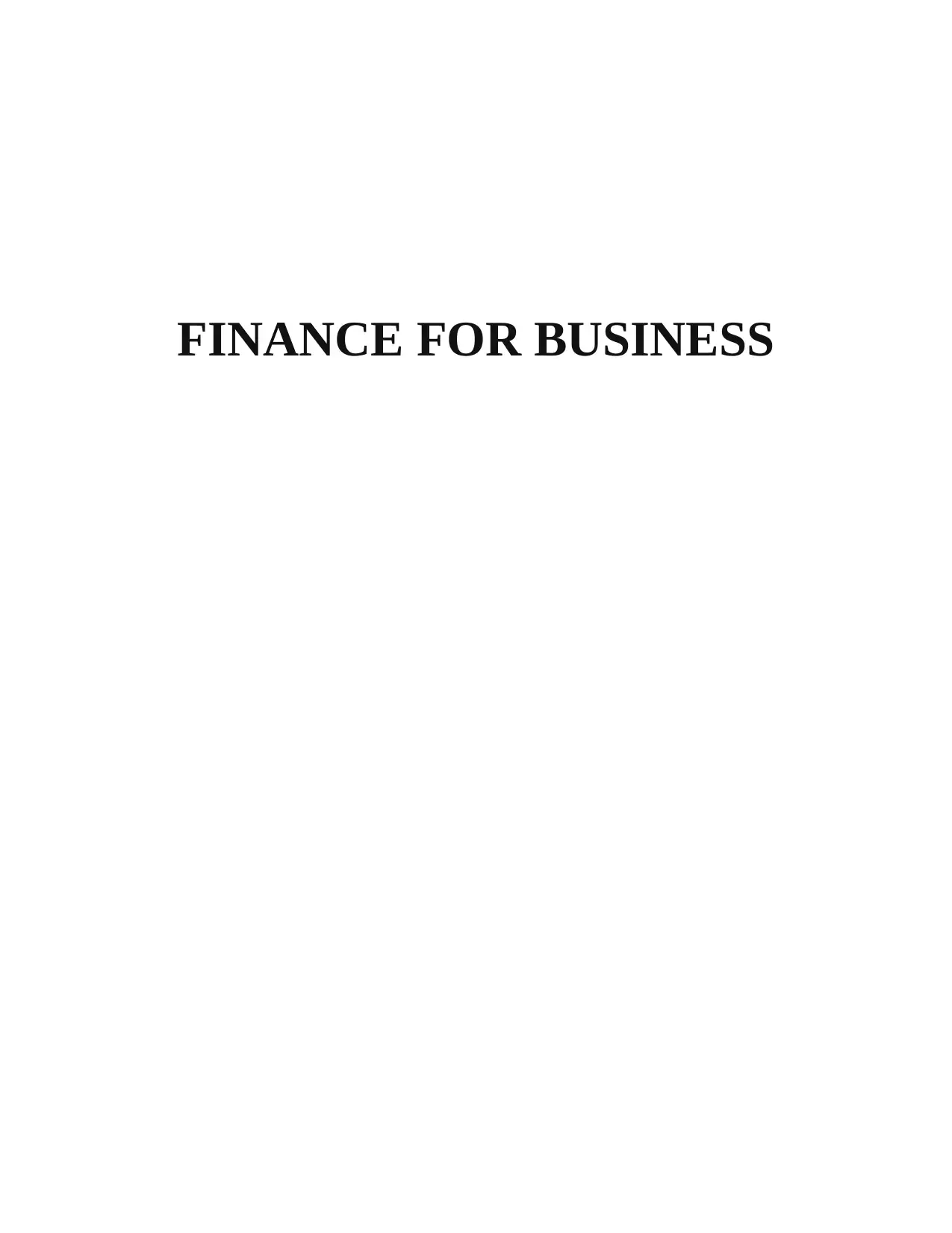
FINANCE FOR BUSINESS
Paraphrase This Document
Need a fresh take? Get an instant paraphrase of this document with our AI Paraphraser
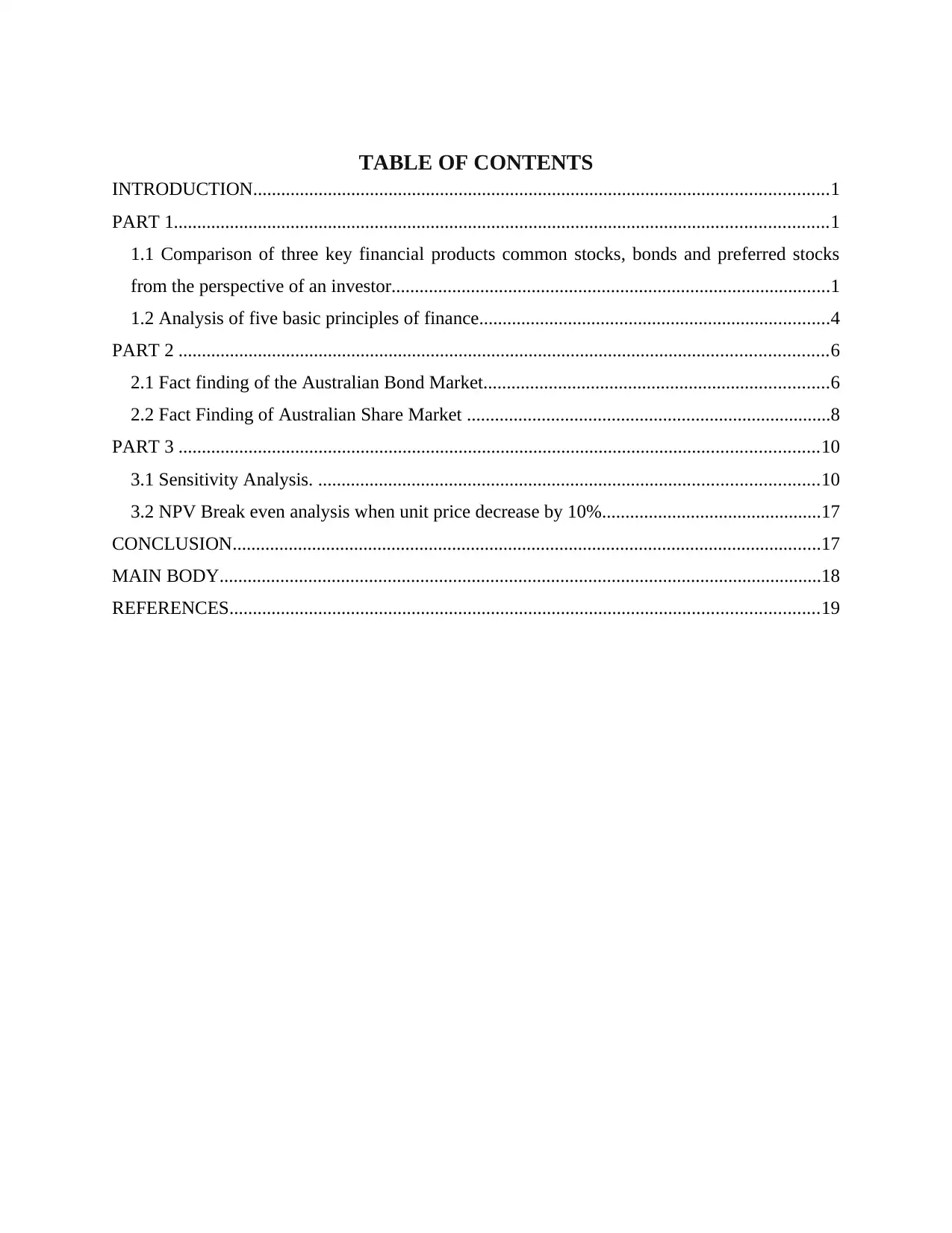
TABLE OF CONTENTS
INTRODUCTION...........................................................................................................................1
PART 1............................................................................................................................................1
1.1 Comparison of three key financial products common stocks, bonds and preferred stocks
from the perspective of an investor..............................................................................................1
1.2 Analysis of five basic principles of finance...........................................................................4
PART 2 ...........................................................................................................................................6
2.1 Fact finding of the Australian Bond Market..........................................................................6
2.2 Fact Finding of Australian Share Market ..............................................................................8
PART 3 .........................................................................................................................................10
3.1 Sensitivity Analysis. ...........................................................................................................10
3.2 NPV Break even analysis when unit price decrease by 10%...............................................17
CONCLUSION..............................................................................................................................17
MAIN BODY.................................................................................................................................18
REFERENCES..............................................................................................................................19
INTRODUCTION...........................................................................................................................1
PART 1............................................................................................................................................1
1.1 Comparison of three key financial products common stocks, bonds and preferred stocks
from the perspective of an investor..............................................................................................1
1.2 Analysis of five basic principles of finance...........................................................................4
PART 2 ...........................................................................................................................................6
2.1 Fact finding of the Australian Bond Market..........................................................................6
2.2 Fact Finding of Australian Share Market ..............................................................................8
PART 3 .........................................................................................................................................10
3.1 Sensitivity Analysis. ...........................................................................................................10
3.2 NPV Break even analysis when unit price decrease by 10%...............................................17
CONCLUSION..............................................................................................................................17
MAIN BODY.................................................................................................................................18
REFERENCES..............................................................................................................................19
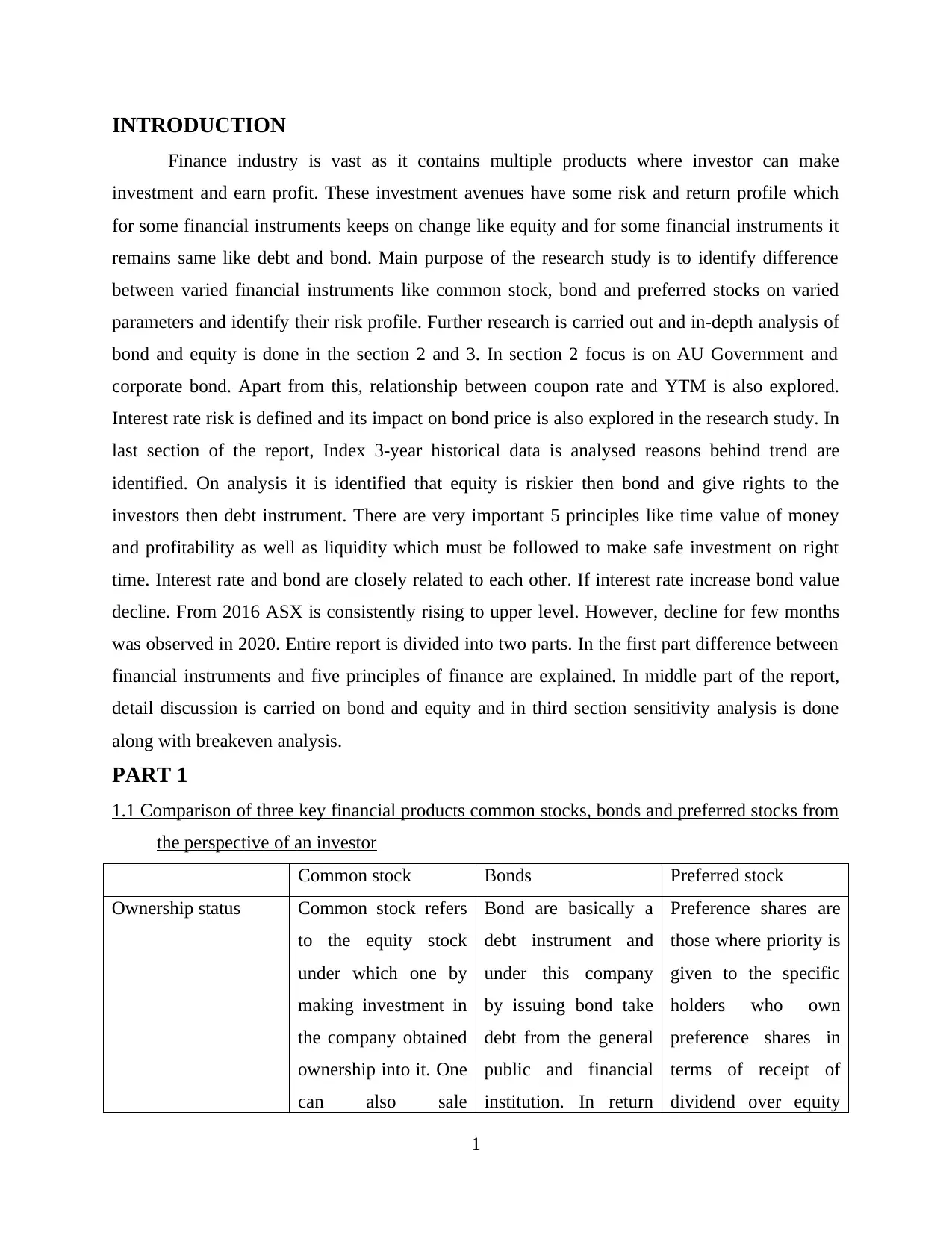
INTRODUCTION
Finance industry is vast as it contains multiple products where investor can make
investment and earn profit. These investment avenues have some risk and return profile which
for some financial instruments keeps on change like equity and for some financial instruments it
remains same like debt and bond. Main purpose of the research study is to identify difference
between varied financial instruments like common stock, bond and preferred stocks on varied
parameters and identify their risk profile. Further research is carried out and in-depth analysis of
bond and equity is done in the section 2 and 3. In section 2 focus is on AU Government and
corporate bond. Apart from this, relationship between coupon rate and YTM is also explored.
Interest rate risk is defined and its impact on bond price is also explored in the research study. In
last section of the report, Index 3-year historical data is analysed reasons behind trend are
identified. On analysis it is identified that equity is riskier then bond and give rights to the
investors then debt instrument. There are very important 5 principles like time value of money
and profitability as well as liquidity which must be followed to make safe investment on right
time. Interest rate and bond are closely related to each other. If interest rate increase bond value
decline. From 2016 ASX is consistently rising to upper level. However, decline for few months
was observed in 2020. Entire report is divided into two parts. In the first part difference between
financial instruments and five principles of finance are explained. In middle part of the report,
detail discussion is carried on bond and equity and in third section sensitivity analysis is done
along with breakeven analysis.
PART 1
1.1 Comparison of three key financial products common stocks, bonds and preferred stocks from
the perspective of an investor
Common stock Bonds Preferred stock
Ownership status Common stock refers
to the equity stock
under which one by
making investment in
the company obtained
ownership into it. One
can also sale
Bond are basically a
debt instrument and
under this company
by issuing bond take
debt from the general
public and financial
institution. In return
Preference shares are
those where priority is
given to the specific
holders who own
preference shares in
terms of receipt of
dividend over equity
1
Finance industry is vast as it contains multiple products where investor can make
investment and earn profit. These investment avenues have some risk and return profile which
for some financial instruments keeps on change like equity and for some financial instruments it
remains same like debt and bond. Main purpose of the research study is to identify difference
between varied financial instruments like common stock, bond and preferred stocks on varied
parameters and identify their risk profile. Further research is carried out and in-depth analysis of
bond and equity is done in the section 2 and 3. In section 2 focus is on AU Government and
corporate bond. Apart from this, relationship between coupon rate and YTM is also explored.
Interest rate risk is defined and its impact on bond price is also explored in the research study. In
last section of the report, Index 3-year historical data is analysed reasons behind trend are
identified. On analysis it is identified that equity is riskier then bond and give rights to the
investors then debt instrument. There are very important 5 principles like time value of money
and profitability as well as liquidity which must be followed to make safe investment on right
time. Interest rate and bond are closely related to each other. If interest rate increase bond value
decline. From 2016 ASX is consistently rising to upper level. However, decline for few months
was observed in 2020. Entire report is divided into two parts. In the first part difference between
financial instruments and five principles of finance are explained. In middle part of the report,
detail discussion is carried on bond and equity and in third section sensitivity analysis is done
along with breakeven analysis.
PART 1
1.1 Comparison of three key financial products common stocks, bonds and preferred stocks from
the perspective of an investor
Common stock Bonds Preferred stock
Ownership status Common stock refers
to the equity stock
under which one by
making investment in
the company obtained
ownership into it. One
can also sale
Bond are basically a
debt instrument and
under this company
by issuing bond take
debt from the general
public and financial
institution. In return
Preference shares are
those where priority is
given to the specific
holders who own
preference shares in
terms of receipt of
dividend over equity
1
⊘ This is a preview!⊘
Do you want full access?
Subscribe today to unlock all pages.

Trusted by 1+ million students worldwide
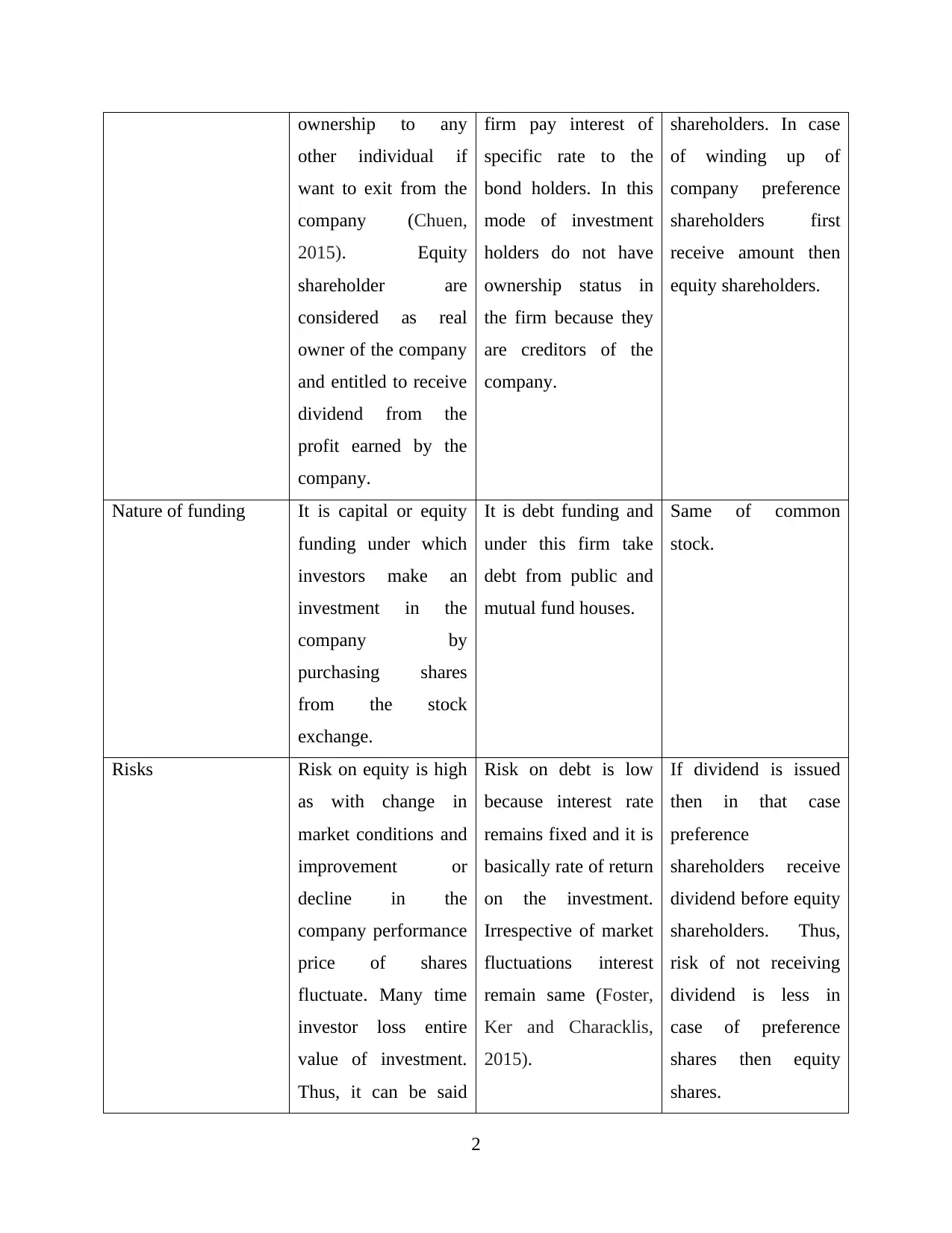
ownership to any
other individual if
want to exit from the
company (Chuen,
2015). Equity
shareholder are
considered as real
owner of the company
and entitled to receive
dividend from the
profit earned by the
company.
firm pay interest of
specific rate to the
bond holders. In this
mode of investment
holders do not have
ownership status in
the firm because they
are creditors of the
company.
shareholders. In case
of winding up of
company preference
shareholders first
receive amount then
equity shareholders.
Nature of funding It is capital or equity
funding under which
investors make an
investment in the
company by
purchasing shares
from the stock
exchange.
It is debt funding and
under this firm take
debt from public and
mutual fund houses.
Same of common
stock.
Risks Risk on equity is high
as with change in
market conditions and
improvement or
decline in the
company performance
price of shares
fluctuate. Many time
investor loss entire
value of investment.
Thus, it can be said
Risk on debt is low
because interest rate
remains fixed and it is
basically rate of return
on the investment.
Irrespective of market
fluctuations interest
remain same (Foster,
Ker and Characklis,
2015).
If dividend is issued
then in that case
preference
shareholders receive
dividend before equity
shareholders. Thus,
risk of not receiving
dividend is less in
case of preference
shares then equity
shares.
2
other individual if
want to exit from the
company (Chuen,
2015). Equity
shareholder are
considered as real
owner of the company
and entitled to receive
dividend from the
profit earned by the
company.
firm pay interest of
specific rate to the
bond holders. In this
mode of investment
holders do not have
ownership status in
the firm because they
are creditors of the
company.
shareholders. In case
of winding up of
company preference
shareholders first
receive amount then
equity shareholders.
Nature of funding It is capital or equity
funding under which
investors make an
investment in the
company by
purchasing shares
from the stock
exchange.
It is debt funding and
under this firm take
debt from public and
mutual fund houses.
Same of common
stock.
Risks Risk on equity is high
as with change in
market conditions and
improvement or
decline in the
company performance
price of shares
fluctuate. Many time
investor loss entire
value of investment.
Thus, it can be said
Risk on debt is low
because interest rate
remains fixed and it is
basically rate of return
on the investment.
Irrespective of market
fluctuations interest
remain same (Foster,
Ker and Characklis,
2015).
If dividend is issued
then in that case
preference
shareholders receive
dividend before equity
shareholders. Thus,
risk of not receiving
dividend is less in
case of preference
shares then equity
shares.
2
Paraphrase This Document
Need a fresh take? Get an instant paraphrase of this document with our AI Paraphraser
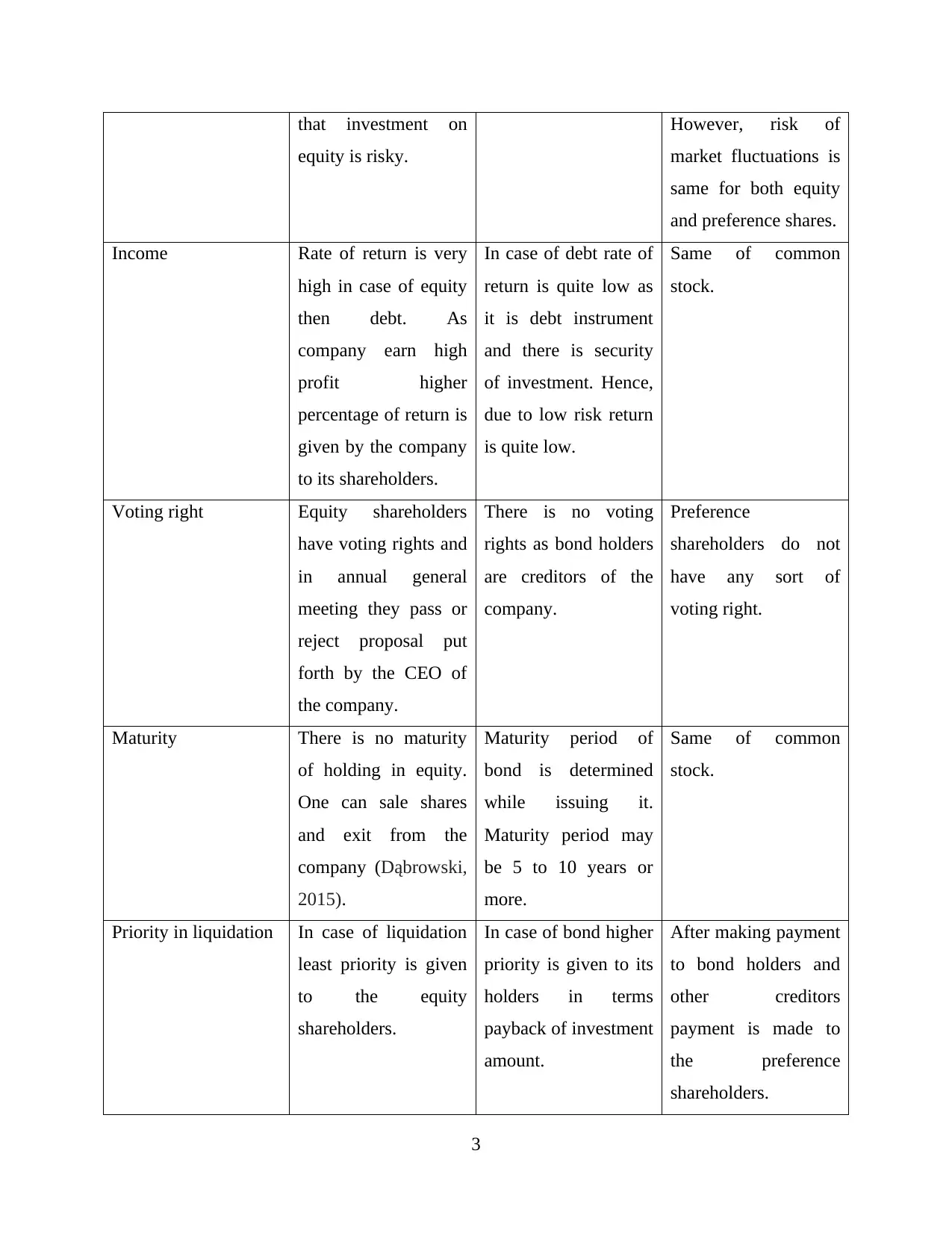
that investment on
equity is risky.
However, risk of
market fluctuations is
same for both equity
and preference shares.
Income Rate of return is very
high in case of equity
then debt. As
company earn high
profit higher
percentage of return is
given by the company
to its shareholders.
In case of debt rate of
return is quite low as
it is debt instrument
and there is security
of investment. Hence,
due to low risk return
is quite low.
Same of common
stock.
Voting right Equity shareholders
have voting rights and
in annual general
meeting they pass or
reject proposal put
forth by the CEO of
the company.
There is no voting
rights as bond holders
are creditors of the
company.
Preference
shareholders do not
have any sort of
voting right.
Maturity There is no maturity
of holding in equity.
One can sale shares
and exit from the
company (Dąbrowski,
2015).
Maturity period of
bond is determined
while issuing it.
Maturity period may
be 5 to 10 years or
more.
Same of common
stock.
Priority in liquidation In case of liquidation
least priority is given
to the equity
shareholders.
In case of bond higher
priority is given to its
holders in terms
payback of investment
amount.
After making payment
to bond holders and
other creditors
payment is made to
the preference
shareholders.
3
equity is risky.
However, risk of
market fluctuations is
same for both equity
and preference shares.
Income Rate of return is very
high in case of equity
then debt. As
company earn high
profit higher
percentage of return is
given by the company
to its shareholders.
In case of debt rate of
return is quite low as
it is debt instrument
and there is security
of investment. Hence,
due to low risk return
is quite low.
Same of common
stock.
Voting right Equity shareholders
have voting rights and
in annual general
meeting they pass or
reject proposal put
forth by the CEO of
the company.
There is no voting
rights as bond holders
are creditors of the
company.
Preference
shareholders do not
have any sort of
voting right.
Maturity There is no maturity
of holding in equity.
One can sale shares
and exit from the
company (Dąbrowski,
2015).
Maturity period of
bond is determined
while issuing it.
Maturity period may
be 5 to 10 years or
more.
Same of common
stock.
Priority in liquidation In case of liquidation
least priority is given
to the equity
shareholders.
In case of bond higher
priority is given to its
holders in terms
payback of investment
amount.
After making payment
to bond holders and
other creditors
payment is made to
the preference
shareholders.
3
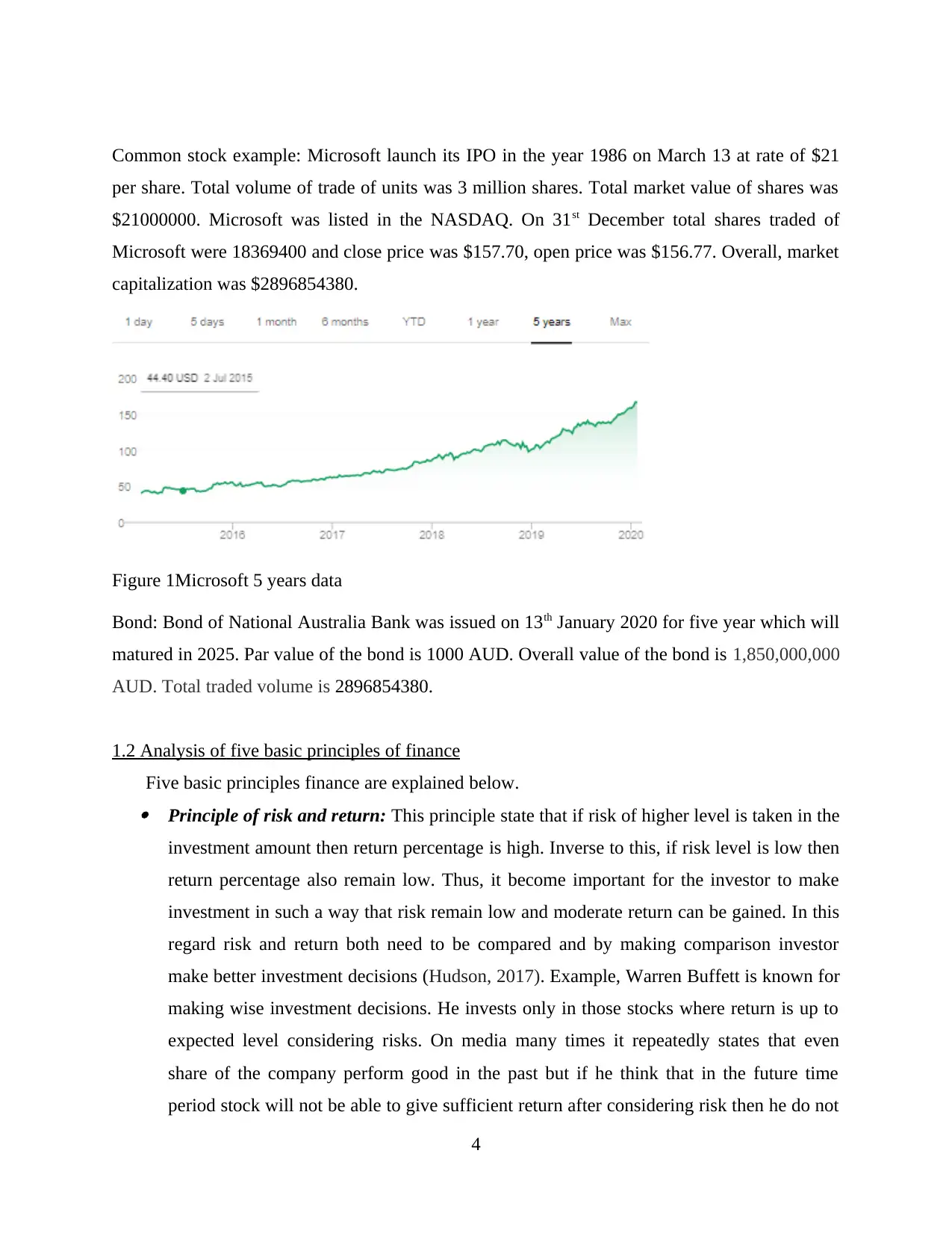
Common stock example: Microsoft launch its IPO in the year 1986 on March 13 at rate of $21
per share. Total volume of trade of units was 3 million shares. Total market value of shares was
$21000000. Microsoft was listed in the NASDAQ. On 31st December total shares traded of
Microsoft were 18369400 and close price was $157.70, open price was $156.77. Overall, market
capitalization was $2896854380.
Figure 1Microsoft 5 years data
Bond: Bond of National Australia Bank was issued on 13th January 2020 for five year which will
matured in 2025. Par value of the bond is 1000 AUD. Overall value of the bond is 1,850,000,000
AUD. Total traded volume is 2896854380.
1.2 Analysis of five basic principles of finance
Five basic principles finance are explained below. Principle of risk and return: This principle state that if risk of higher level is taken in the
investment amount then return percentage is high. Inverse to this, if risk level is low then
return percentage also remain low. Thus, it become important for the investor to make
investment in such a way that risk remain low and moderate return can be gained. In this
regard risk and return both need to be compared and by making comparison investor
make better investment decisions (Hudson, 2017). Example, Warren Buffett is known for
making wise investment decisions. He invests only in those stocks where return is up to
expected level considering risks. On media many times it repeatedly states that even
share of the company perform good in the past but if he think that in the future time
period stock will not be able to give sufficient return after considering risk then he do not
4
per share. Total volume of trade of units was 3 million shares. Total market value of shares was
$21000000. Microsoft was listed in the NASDAQ. On 31st December total shares traded of
Microsoft were 18369400 and close price was $157.70, open price was $156.77. Overall, market
capitalization was $2896854380.
Figure 1Microsoft 5 years data
Bond: Bond of National Australia Bank was issued on 13th January 2020 for five year which will
matured in 2025. Par value of the bond is 1000 AUD. Overall value of the bond is 1,850,000,000
AUD. Total traded volume is 2896854380.
1.2 Analysis of five basic principles of finance
Five basic principles finance are explained below. Principle of risk and return: This principle state that if risk of higher level is taken in the
investment amount then return percentage is high. Inverse to this, if risk level is low then
return percentage also remain low. Thus, it become important for the investor to make
investment in such a way that risk remain low and moderate return can be gained. In this
regard risk and return both need to be compared and by making comparison investor
make better investment decisions (Hudson, 2017). Example, Warren Buffett is known for
making wise investment decisions. He invests only in those stocks where return is up to
expected level considering risks. On media many times it repeatedly states that even
share of the company perform good in the past but if he think that in the future time
period stock will not be able to give sufficient return after considering risk then he do not
4
⊘ This is a preview!⊘
Do you want full access?
Subscribe today to unlock all pages.

Trusted by 1+ million students worldwide
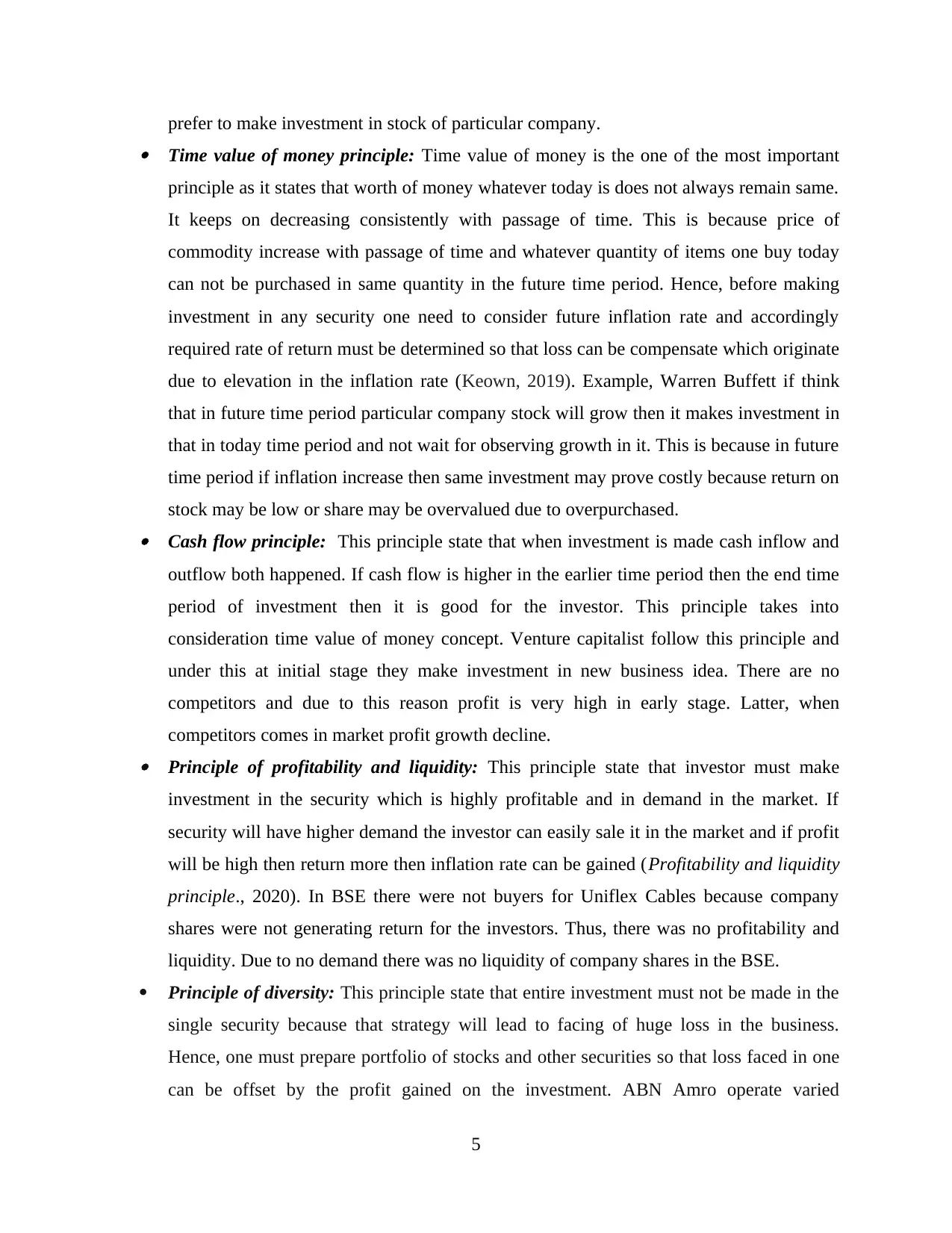
prefer to make investment in stock of particular company. Time value of money principle: Time value of money is the one of the most important
principle as it states that worth of money whatever today is does not always remain same.
It keeps on decreasing consistently with passage of time. This is because price of
commodity increase with passage of time and whatever quantity of items one buy today
can not be purchased in same quantity in the future time period. Hence, before making
investment in any security one need to consider future inflation rate and accordingly
required rate of return must be determined so that loss can be compensate which originate
due to elevation in the inflation rate (Keown, 2019). Example, Warren Buffett if think
that in future time period particular company stock will grow then it makes investment in
that in today time period and not wait for observing growth in it. This is because in future
time period if inflation increase then same investment may prove costly because return on
stock may be low or share may be overvalued due to overpurchased. Cash flow principle: This principle state that when investment is made cash inflow and
outflow both happened. If cash flow is higher in the earlier time period then the end time
period of investment then it is good for the investor. This principle takes into
consideration time value of money concept. Venture capitalist follow this principle and
under this at initial stage they make investment in new business idea. There are no
competitors and due to this reason profit is very high in early stage. Latter, when
competitors comes in market profit growth decline. Principle of profitability and liquidity: This principle state that investor must make
investment in the security which is highly profitable and in demand in the market. If
security will have higher demand the investor can easily sale it in the market and if profit
will be high then return more then inflation rate can be gained (Profitability and liquidity
principle., 2020). In BSE there were not buyers for Uniflex Cables because company
shares were not generating return for the investors. Thus, there was no profitability and
liquidity. Due to no demand there was no liquidity of company shares in the BSE.
Principle of diversity: This principle state that entire investment must not be made in the
single security because that strategy will lead to facing of huge loss in the business.
Hence, one must prepare portfolio of stocks and other securities so that loss faced in one
can be offset by the profit gained on the investment. ABN Amro operate varied
5
principle as it states that worth of money whatever today is does not always remain same.
It keeps on decreasing consistently with passage of time. This is because price of
commodity increase with passage of time and whatever quantity of items one buy today
can not be purchased in same quantity in the future time period. Hence, before making
investment in any security one need to consider future inflation rate and accordingly
required rate of return must be determined so that loss can be compensate which originate
due to elevation in the inflation rate (Keown, 2019). Example, Warren Buffett if think
that in future time period particular company stock will grow then it makes investment in
that in today time period and not wait for observing growth in it. This is because in future
time period if inflation increase then same investment may prove costly because return on
stock may be low or share may be overvalued due to overpurchased. Cash flow principle: This principle state that when investment is made cash inflow and
outflow both happened. If cash flow is higher in the earlier time period then the end time
period of investment then it is good for the investor. This principle takes into
consideration time value of money concept. Venture capitalist follow this principle and
under this at initial stage they make investment in new business idea. There are no
competitors and due to this reason profit is very high in early stage. Latter, when
competitors comes in market profit growth decline. Principle of profitability and liquidity: This principle state that investor must make
investment in the security which is highly profitable and in demand in the market. If
security will have higher demand the investor can easily sale it in the market and if profit
will be high then return more then inflation rate can be gained (Profitability and liquidity
principle., 2020). In BSE there were not buyers for Uniflex Cables because company
shares were not generating return for the investors. Thus, there was no profitability and
liquidity. Due to no demand there was no liquidity of company shares in the BSE.
Principle of diversity: This principle state that entire investment must not be made in the
single security because that strategy will lead to facing of huge loss in the business.
Hence, one must prepare portfolio of stocks and other securities so that loss faced in one
can be offset by the profit gained on the investment. ABN Amro operate varied
5
Paraphrase This Document
Need a fresh take? Get an instant paraphrase of this document with our AI Paraphraser
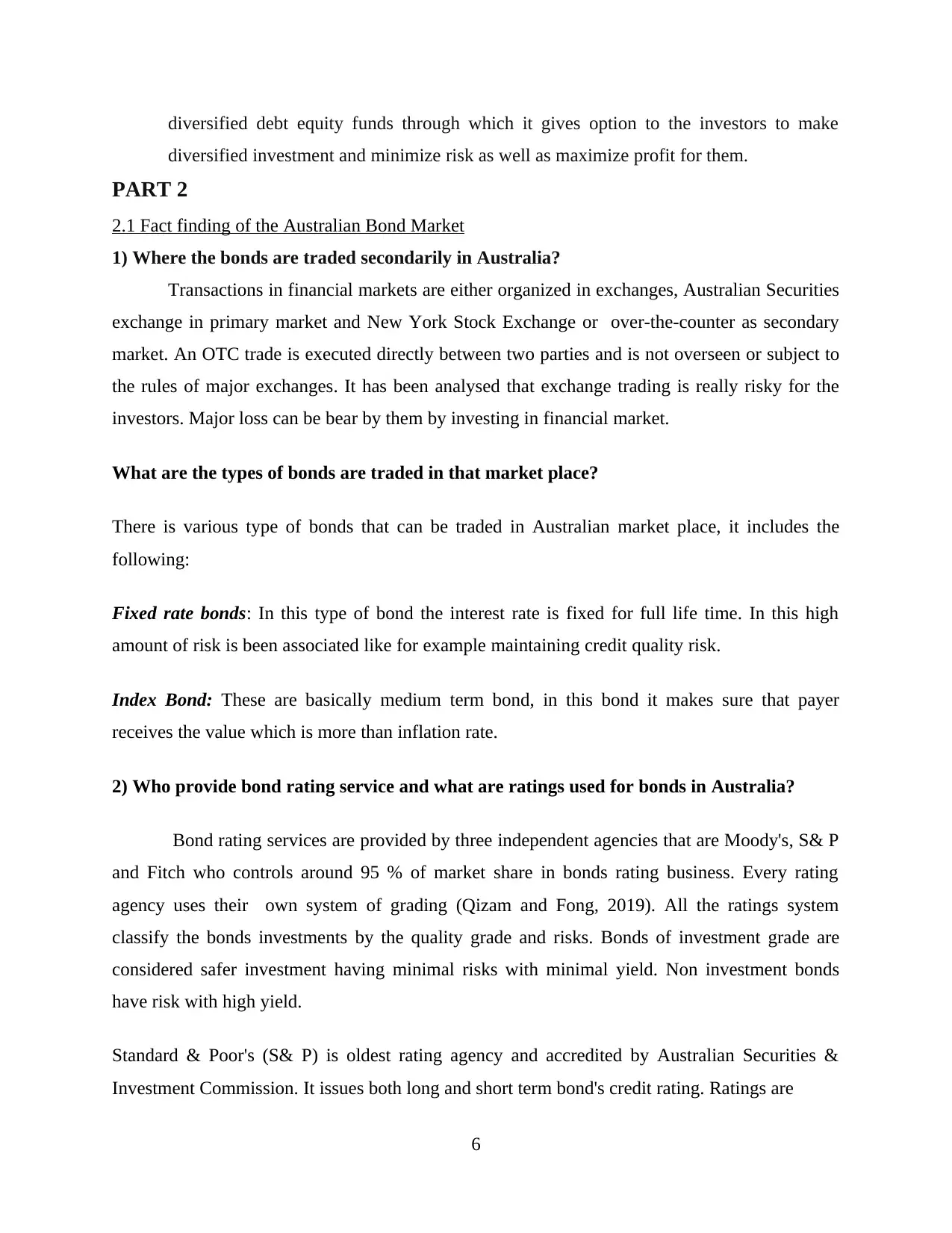
diversified debt equity funds through which it gives option to the investors to make
diversified investment and minimize risk as well as maximize profit for them.
PART 2
2.1 Fact finding of the Australian Bond Market
1) Where the bonds are traded secondarily in Australia?
Transactions in financial markets are either organized in exchanges, Australian Securities
exchange in primary market and New York Stock Exchange or over-the-counter as secondary
market. An OTC trade is executed directly between two parties and is not overseen or subject to
the rules of major exchanges. It has been analysed that exchange trading is really risky for the
investors. Major loss can be bear by them by investing in financial market.
What are the types of bonds are traded in that market place?
There is various type of bonds that can be traded in Australian market place, it includes the
following:
Fixed rate bonds: In this type of bond the interest rate is fixed for full life time. In this high
amount of risk is been associated like for example maintaining credit quality risk.
Index Bond: These are basically medium term bond, in this bond it makes sure that payer
receives the value which is more than inflation rate.
2) Who provide bond rating service and what are ratings used for bonds in Australia?
Bond rating services are provided by three independent agencies that are Moody's, S& P
and Fitch who controls around 95 % of market share in bonds rating business. Every rating
agency uses their own system of grading (Qizam and Fong, 2019). All the ratings system
classify the bonds investments by the quality grade and risks. Bonds of investment grade are
considered safer investment having minimal risks with minimal yield. Non investment bonds
have risk with high yield.
Standard & Poor's (S& P) is oldest rating agency and accredited by Australian Securities &
Investment Commission. It issues both long and short term bond's credit rating. Ratings are
6
diversified investment and minimize risk as well as maximize profit for them.
PART 2
2.1 Fact finding of the Australian Bond Market
1) Where the bonds are traded secondarily in Australia?
Transactions in financial markets are either organized in exchanges, Australian Securities
exchange in primary market and New York Stock Exchange or over-the-counter as secondary
market. An OTC trade is executed directly between two parties and is not overseen or subject to
the rules of major exchanges. It has been analysed that exchange trading is really risky for the
investors. Major loss can be bear by them by investing in financial market.
What are the types of bonds are traded in that market place?
There is various type of bonds that can be traded in Australian market place, it includes the
following:
Fixed rate bonds: In this type of bond the interest rate is fixed for full life time. In this high
amount of risk is been associated like for example maintaining credit quality risk.
Index Bond: These are basically medium term bond, in this bond it makes sure that payer
receives the value which is more than inflation rate.
2) Who provide bond rating service and what are ratings used for bonds in Australia?
Bond rating services are provided by three independent agencies that are Moody's, S& P
and Fitch who controls around 95 % of market share in bonds rating business. Every rating
agency uses their own system of grading (Qizam and Fong, 2019). All the ratings system
classify the bonds investments by the quality grade and risks. Bonds of investment grade are
considered safer investment having minimal risks with minimal yield. Non investment bonds
have risk with high yield.
Standard & Poor's (S& P) is oldest rating agency and accredited by Australian Securities &
Investment Commission. It issues both long and short term bond's credit rating. Ratings are
6
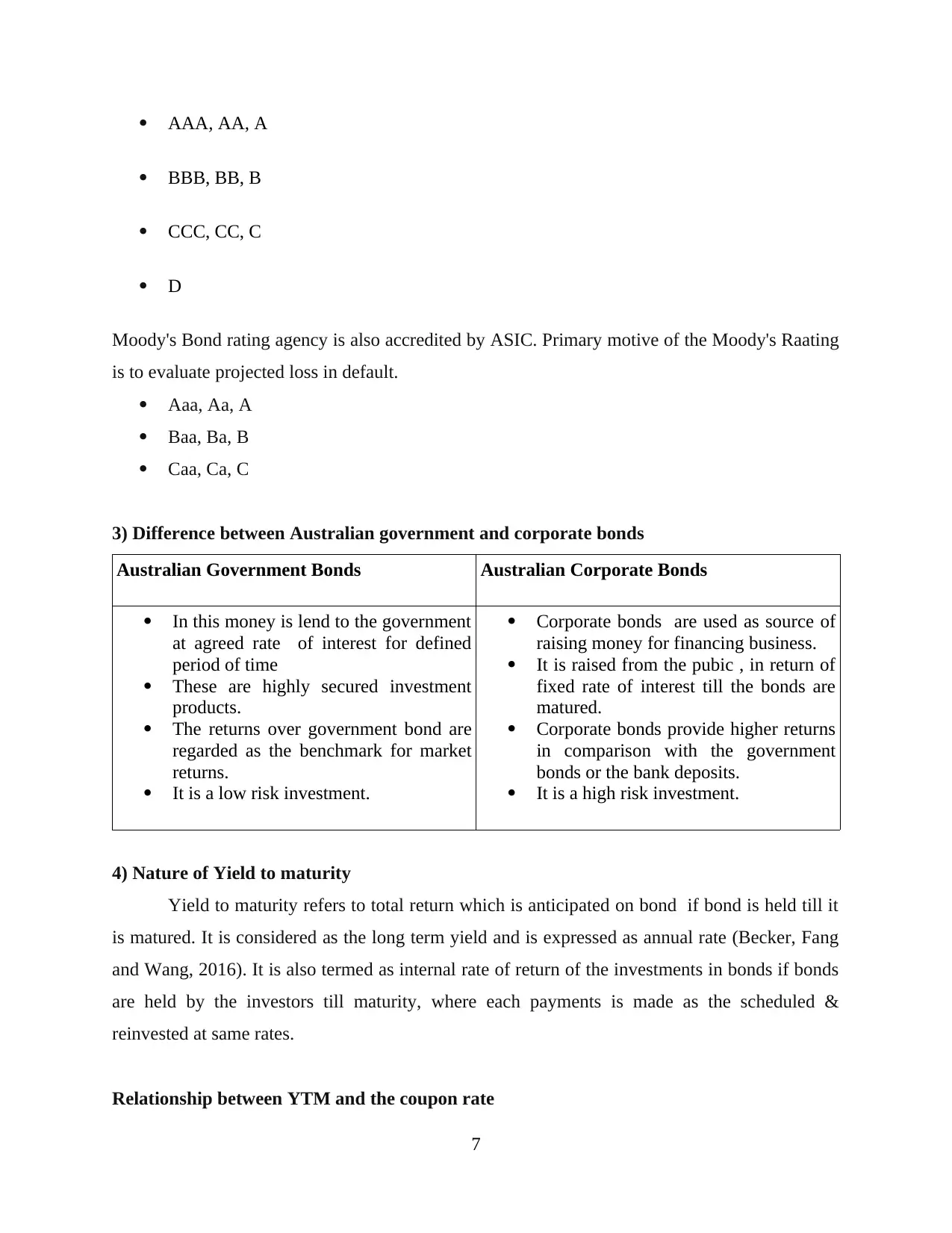
AAA, AA, A
BBB, BB, B
CCC, CC, C
D
Moody's Bond rating agency is also accredited by ASIC. Primary motive of the Moody's Raating
is to evaluate projected loss in default.
Aaa, Aa, A
Baa, Ba, B
Caa, Ca, C
3) Difference between Australian government and corporate bonds
Australian Government Bonds Australian Corporate Bonds
In this money is lend to the government
at agreed rate of interest for defined
period of time
These are highly secured investment
products.
The returns over government bond are
regarded as the benchmark for market
returns.
It is a low risk investment.
Corporate bonds are used as source of
raising money for financing business.
It is raised from the pubic , in return of
fixed rate of interest till the bonds are
matured.
Corporate bonds provide higher returns
in comparison with the government
bonds or the bank deposits.
It is a high risk investment.
4) Nature of Yield to maturity
Yield to maturity refers to total return which is anticipated on bond if bond is held till it
is matured. It is considered as the long term yield and is expressed as annual rate (Becker, Fang
and Wang, 2016). It is also termed as internal rate of return of the investments in bonds if bonds
are held by the investors till maturity, where each payments is made as the scheduled &
reinvested at same rates.
Relationship between YTM and the coupon rate
7
BBB, BB, B
CCC, CC, C
D
Moody's Bond rating agency is also accredited by ASIC. Primary motive of the Moody's Raating
is to evaluate projected loss in default.
Aaa, Aa, A
Baa, Ba, B
Caa, Ca, C
3) Difference between Australian government and corporate bonds
Australian Government Bonds Australian Corporate Bonds
In this money is lend to the government
at agreed rate of interest for defined
period of time
These are highly secured investment
products.
The returns over government bond are
regarded as the benchmark for market
returns.
It is a low risk investment.
Corporate bonds are used as source of
raising money for financing business.
It is raised from the pubic , in return of
fixed rate of interest till the bonds are
matured.
Corporate bonds provide higher returns
in comparison with the government
bonds or the bank deposits.
It is a high risk investment.
4) Nature of Yield to maturity
Yield to maturity refers to total return which is anticipated on bond if bond is held till it
is matured. It is considered as the long term yield and is expressed as annual rate (Becker, Fang
and Wang, 2016). It is also termed as internal rate of return of the investments in bonds if bonds
are held by the investors till maturity, where each payments is made as the scheduled &
reinvested at same rates.
Relationship between YTM and the coupon rate
7
⊘ This is a preview!⊘
Do you want full access?
Subscribe today to unlock all pages.

Trusted by 1+ million students worldwide
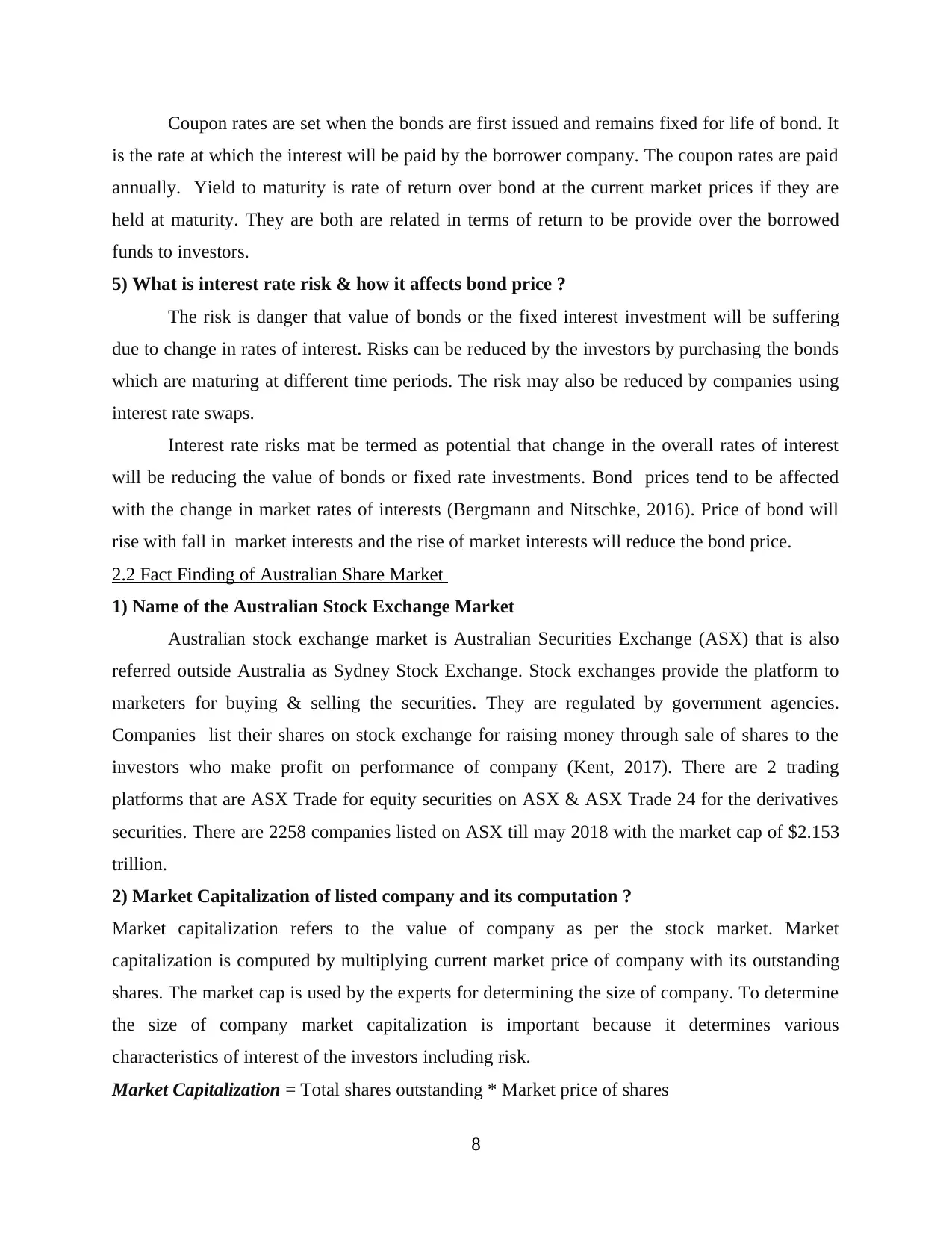
Coupon rates are set when the bonds are first issued and remains fixed for life of bond. It
is the rate at which the interest will be paid by the borrower company. The coupon rates are paid
annually. Yield to maturity is rate of return over bond at the current market prices if they are
held at maturity. They are both are related in terms of return to be provide over the borrowed
funds to investors.
5) What is interest rate risk & how it affects bond price ?
The risk is danger that value of bonds or the fixed interest investment will be suffering
due to change in rates of interest. Risks can be reduced by the investors by purchasing the bonds
which are maturing at different time periods. The risk may also be reduced by companies using
interest rate swaps.
Interest rate risks mat be termed as potential that change in the overall rates of interest
will be reducing the value of bonds or fixed rate investments. Bond prices tend to be affected
with the change in market rates of interests (Bergmann and Nitschke, 2016). Price of bond will
rise with fall in market interests and the rise of market interests will reduce the bond price.
2.2 Fact Finding of Australian Share Market
1) Name of the Australian Stock Exchange Market
Australian stock exchange market is Australian Securities Exchange (ASX) that is also
referred outside Australia as Sydney Stock Exchange. Stock exchanges provide the platform to
marketers for buying & selling the securities. They are regulated by government agencies.
Companies list their shares on stock exchange for raising money through sale of shares to the
investors who make profit on performance of company (Kent, 2017). There are 2 trading
platforms that are ASX Trade for equity securities on ASX & ASX Trade 24 for the derivatives
securities. There are 2258 companies listed on ASX till may 2018 with the market cap of $2.153
trillion.
2) Market Capitalization of listed company and its computation ?
Market capitalization refers to the value of company as per the stock market. Market
capitalization is computed by multiplying current market price of company with its outstanding
shares. The market cap is used by the experts for determining the size of company. To determine
the size of company market capitalization is important because it determines various
characteristics of interest of the investors including risk.
Market Capitalization = Total shares outstanding * Market price of shares
8
is the rate at which the interest will be paid by the borrower company. The coupon rates are paid
annually. Yield to maturity is rate of return over bond at the current market prices if they are
held at maturity. They are both are related in terms of return to be provide over the borrowed
funds to investors.
5) What is interest rate risk & how it affects bond price ?
The risk is danger that value of bonds or the fixed interest investment will be suffering
due to change in rates of interest. Risks can be reduced by the investors by purchasing the bonds
which are maturing at different time periods. The risk may also be reduced by companies using
interest rate swaps.
Interest rate risks mat be termed as potential that change in the overall rates of interest
will be reducing the value of bonds or fixed rate investments. Bond prices tend to be affected
with the change in market rates of interests (Bergmann and Nitschke, 2016). Price of bond will
rise with fall in market interests and the rise of market interests will reduce the bond price.
2.2 Fact Finding of Australian Share Market
1) Name of the Australian Stock Exchange Market
Australian stock exchange market is Australian Securities Exchange (ASX) that is also
referred outside Australia as Sydney Stock Exchange. Stock exchanges provide the platform to
marketers for buying & selling the securities. They are regulated by government agencies.
Companies list their shares on stock exchange for raising money through sale of shares to the
investors who make profit on performance of company (Kent, 2017). There are 2 trading
platforms that are ASX Trade for equity securities on ASX & ASX Trade 24 for the derivatives
securities. There are 2258 companies listed on ASX till may 2018 with the market cap of $2.153
trillion.
2) Market Capitalization of listed company and its computation ?
Market capitalization refers to the value of company as per the stock market. Market
capitalization is computed by multiplying current market price of company with its outstanding
shares. The market cap is used by the experts for determining the size of company. To determine
the size of company market capitalization is important because it determines various
characteristics of interest of the investors including risk.
Market Capitalization = Total shares outstanding * Market price of shares
8
Paraphrase This Document
Need a fresh take? Get an instant paraphrase of this document with our AI Paraphraser
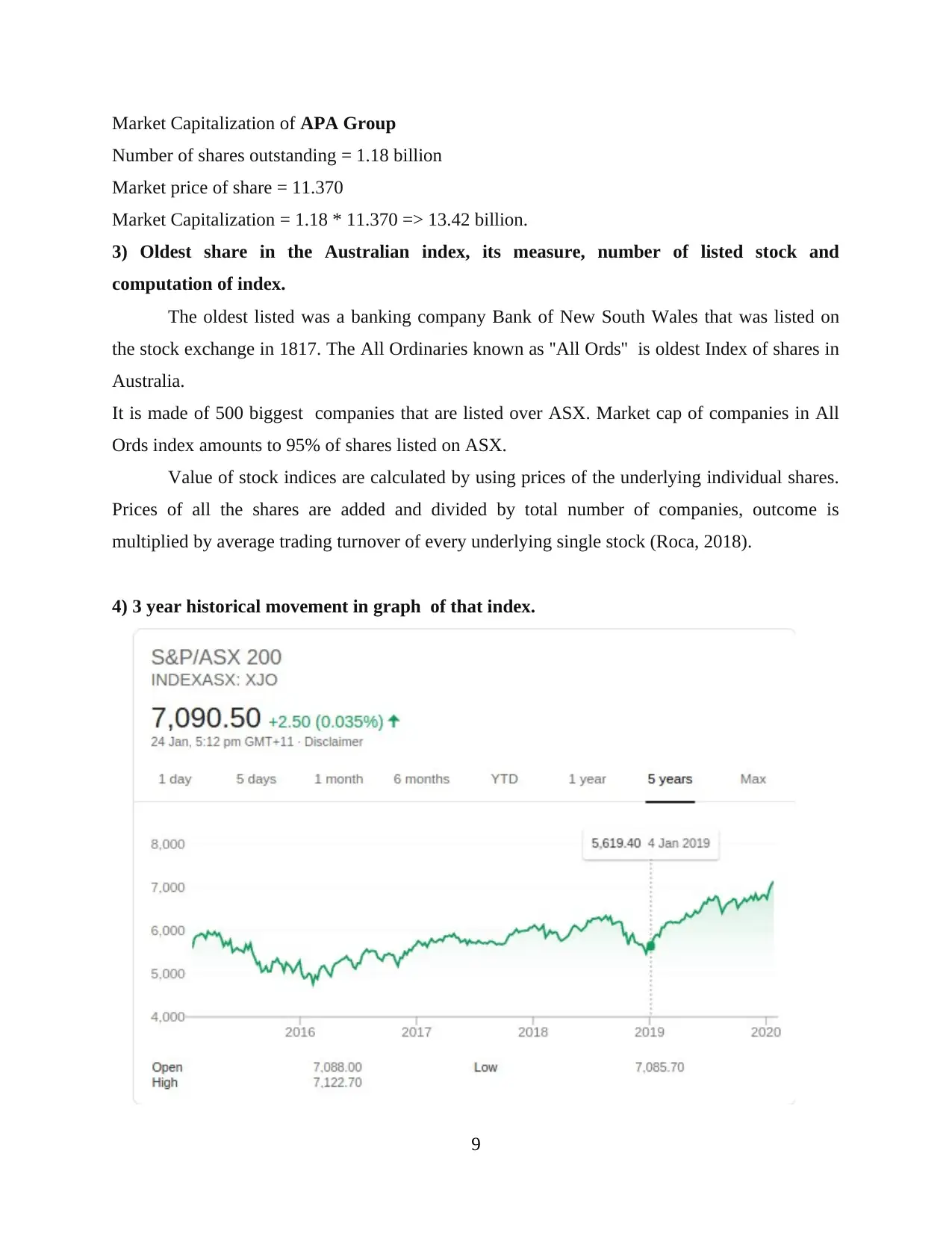
Market Capitalization of APA Group
Number of shares outstanding = 1.18 billion
Market price of share = 11.370
Market Capitalization = 1.18 * 11.370 => 13.42 billion.
3) Oldest share in the Australian index, its measure, number of listed stock and
computation of index.
The oldest listed was a banking company Bank of New South Wales that was listed on
the stock exchange in 1817. The All Ordinaries known as ''All Ords'' is oldest Index of shares in
Australia.
It is made of 500 biggest companies that are listed over ASX. Market cap of companies in All
Ords index amounts to 95% of shares listed on ASX.
Value of stock indices are calculated by using prices of the underlying individual shares.
Prices of all the shares are added and divided by total number of companies, outcome is
multiplied by average trading turnover of every underlying single stock (Roca, 2018).
4) 3 year historical movement in graph of that index.
9
Number of shares outstanding = 1.18 billion
Market price of share = 11.370
Market Capitalization = 1.18 * 11.370 => 13.42 billion.
3) Oldest share in the Australian index, its measure, number of listed stock and
computation of index.
The oldest listed was a banking company Bank of New South Wales that was listed on
the stock exchange in 1817. The All Ordinaries known as ''All Ords'' is oldest Index of shares in
Australia.
It is made of 500 biggest companies that are listed over ASX. Market cap of companies in All
Ords index amounts to 95% of shares listed on ASX.
Value of stock indices are calculated by using prices of the underlying individual shares.
Prices of all the shares are added and divided by total number of companies, outcome is
multiplied by average trading turnover of every underlying single stock (Roca, 2018).
4) 3 year historical movement in graph of that index.
9
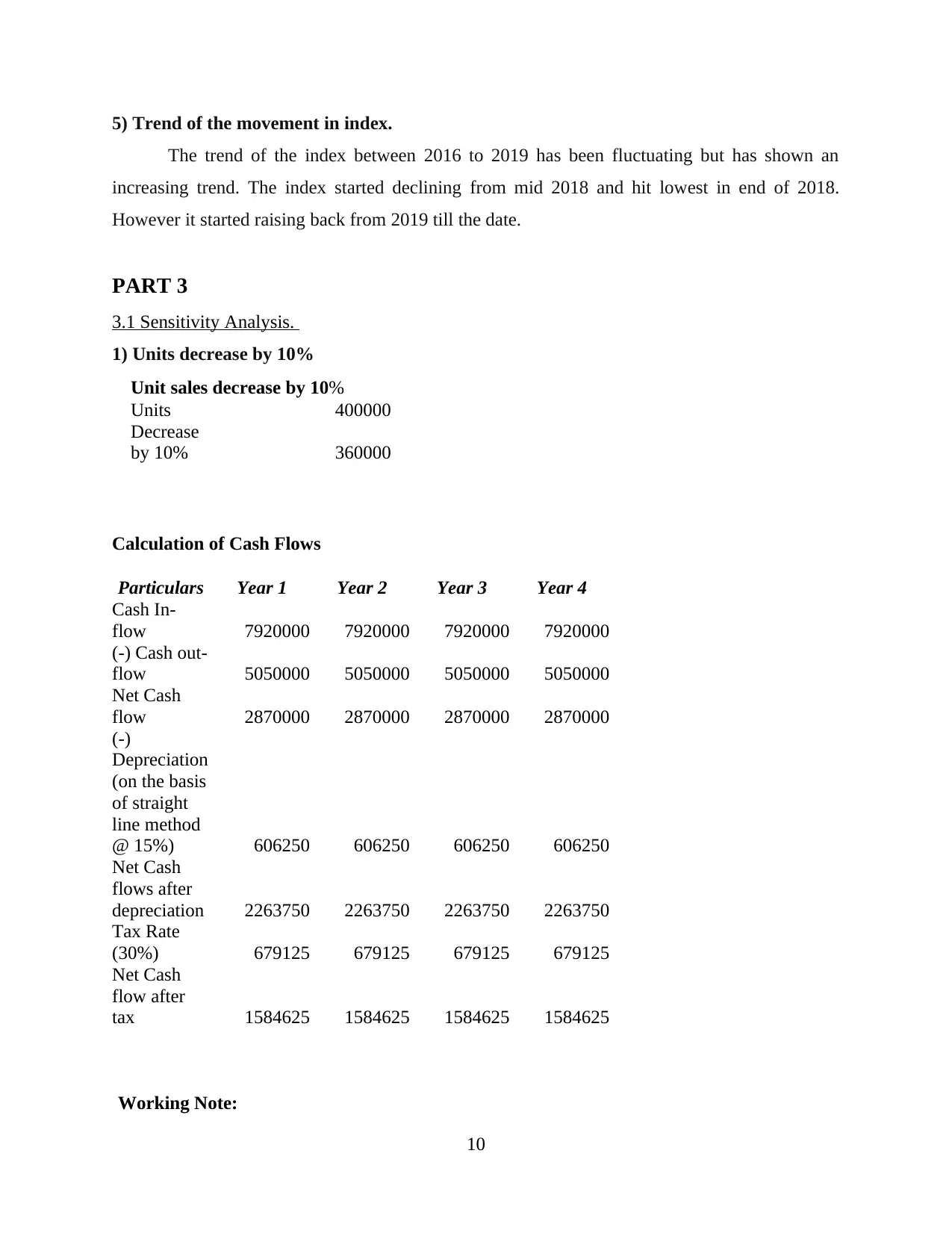
5) Trend of the movement in index.
The trend of the index between 2016 to 2019 has been fluctuating but has shown an
increasing trend. The index started declining from mid 2018 and hit lowest in end of 2018.
However it started raising back from 2019 till the date.
PART 3
3.1 Sensitivity Analysis.
1) Units decrease by 10%
Unit sales decrease by 10%
Units 400000
Decrease
by 10% 360000
Calculation of Cash Flows
Particulars Year 1 Year 2 Year 3 Year 4
Cash In-
flow 7920000 7920000 7920000 7920000
(-) Cash out-
flow 5050000 5050000 5050000 5050000
Net Cash
flow 2870000 2870000 2870000 2870000
(-)
Depreciation
(on the basis
of straight
line method
@ 15%) 606250 606250 606250 606250
Net Cash
flows after
depreciation 2263750 2263750 2263750 2263750
Tax Rate
(30%) 679125 679125 679125 679125
Net Cash
flow after
tax 1584625 1584625 1584625 1584625
Working Note:
10
The trend of the index between 2016 to 2019 has been fluctuating but has shown an
increasing trend. The index started declining from mid 2018 and hit lowest in end of 2018.
However it started raising back from 2019 till the date.
PART 3
3.1 Sensitivity Analysis.
1) Units decrease by 10%
Unit sales decrease by 10%
Units 400000
Decrease
by 10% 360000
Calculation of Cash Flows
Particulars Year 1 Year 2 Year 3 Year 4
Cash In-
flow 7920000 7920000 7920000 7920000
(-) Cash out-
flow 5050000 5050000 5050000 5050000
Net Cash
flow 2870000 2870000 2870000 2870000
(-)
Depreciation
(on the basis
of straight
line method
@ 15%) 606250 606250 606250 606250
Net Cash
flows after
depreciation 2263750 2263750 2263750 2263750
Tax Rate
(30%) 679125 679125 679125 679125
Net Cash
flow after
tax 1584625 1584625 1584625 1584625
Working Note:
10
⊘ This is a preview!⊘
Do you want full access?
Subscribe today to unlock all pages.

Trusted by 1+ million students worldwide
1 out of 20
Related Documents
Your All-in-One AI-Powered Toolkit for Academic Success.
+13062052269
info@desklib.com
Available 24*7 on WhatsApp / Email
![[object Object]](/_next/static/media/star-bottom.7253800d.svg)
Unlock your academic potential
Copyright © 2020–2025 A2Z Services. All Rights Reserved. Developed and managed by ZUCOL.




